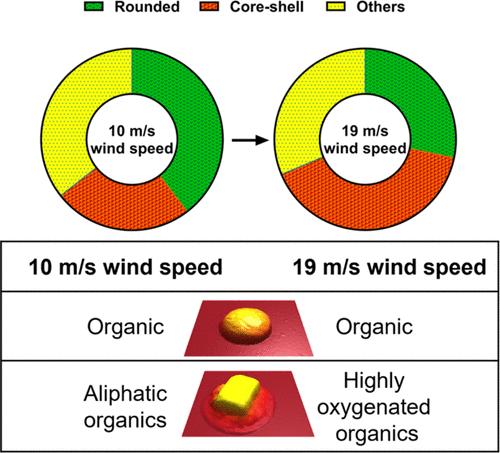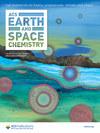Effects of Wind Speed on Size-Dependent Morphology and Composition of Sea Spray Aerosols
IF 2.9
3区 化学
Q2 CHEMISTRY, MULTIDISCIPLINARY
引用次数: 0
Abstract
Variable wind speeds over the ocean can have a significant impact on the formation mechanism and physical-chemical properties of sea spray aerosols (SSA), which in turn influence their climate-relevant impacts. Herein, for the first time, we investigate the effects of wind speed on size-dependent morphology and composition of individual nascent SSA generated from wind-wave interactions of natural seawater within a wind-wave channel as a function of size and their particle-to-particle variability. Filter-based thermal optical analysis, atomic force microscopy (AFM), AFM infrared spectroscopy (AFM-IR), and scanning electron microscopy (SEM) were employed in this regard. This study focuses on SSA with sizes within 0.04–1.8 μm generated at two wind speeds: 10 m/s, representing a wind lull scenario over the ocean, and 19 m/s, indicative of the wind speeds encountered in stormy conditions. Filter-based measurements revealed a reduction of the organic mass fraction as the wind speed increases. AFM imaging at 20% relative humidity of individual SSA identified six main morphologies: prism-like, rounded, core–shell, rod, rod inclusion core–shell, and aggregates. At 10 m/s, most SSA were rounded, while at 19 m/s, core–shells became predominant. Based on AFM-IR, rounded SSA at both wind speeds had similar composition, mainly composed of aliphatic and oxygenated species, whereas the shells of core–shells displayed more oxygenated organics at 19 m/s and more aliphatic organics at 10 m/s. Collectively, our observations can be attributed to the disruption of the sea surface microlayer film structure at higher wind speeds. The findings reveal a significant impact of wind speed on morphology and composition of SSA, which should be accounted for accurate assessment of their climate effects.

风速对海雾气溶胶大小形态和成分的影响
海洋上空的风速变化会对海雾气溶胶(SSA)的形成机制和物理化学特性产生重大影响,进而影响其对气候的相关影响。在此,我们首次研究了风速对风浪通道内天然海水与风浪相互作用产生的单个新生海雾气溶胶的大小依赖性形态和组成的影响,以及它们的大小和颗粒间变化的函数。在这方面采用了基于滤光片的热光学分析、原子力显微镜(AFM)、AFM 红外光谱(AFM-IR)和扫描电子显微镜(SEM)。本研究的重点是在两种风速下产生的尺寸在 0.04-1.8 μm 范围内的 SSA:10 米/秒和 19 米/秒两种风速下产生的尺寸在 0.04-1.8 μm 之间的 SSA。基于滤波器的测量结果显示,随着风速的增加,有机物的质量分数也在减少。在相对湿度为 20% 的条件下,对单个 SSA 进行原子力显微镜成像,确定了六种主要形态:棱镜状、圆形、核壳状、棒状、棒包核壳状和聚集体。在 10 米/秒的速度下,大多数 SSA 呈圆形,而在 19 米/秒的速度下,核壳成为主要形态。根据原子力显微镜-红外光谱(AFM-IR),两种风速下的圆形 SSA 成分相似,主要由脂肪族和含氧物种组成,而核壳的外壳在 19 米/秒时显示出更多的含氧有机物,在 10 米/秒时显示出更多的脂肪族有机物。总之,我们的观测结果可归因于较高风速下海面微层膜结构的破坏。这些发现揭示了风速对 SSA 形态和组成的重大影响,应考虑到这一点才能准确评估其气候效应。
本文章由计算机程序翻译,如有差异,请以英文原文为准。
求助全文
约1分钟内获得全文
求助全文
来源期刊

ACS Earth and Space Chemistry
Earth and Planetary Sciences-Geochemistry and Petrology
CiteScore
5.30
自引率
11.80%
发文量
249
期刊介绍:
The scope of ACS Earth and Space Chemistry includes the application of analytical, experimental and theoretical chemistry to investigate research questions relevant to the Earth and Space. The journal encompasses the highly interdisciplinary nature of research in this area, while emphasizing chemistry and chemical research tools as the unifying theme. The journal publishes broadly in the domains of high- and low-temperature geochemistry, atmospheric chemistry, marine chemistry, planetary chemistry, astrochemistry, and analytical geochemistry. ACS Earth and Space Chemistry publishes Articles, Letters, Reviews, and Features to provide flexible formats to readily communicate all aspects of research in these fields.
 求助内容:
求助内容: 应助结果提醒方式:
应助结果提醒方式:


